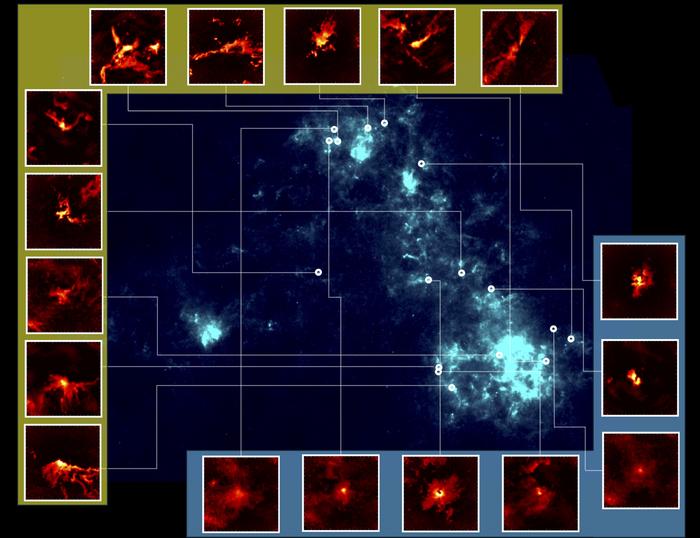Some Stars Are Born From Fluffy Clouds in the Early Universe
Posted on Categories Discover Magazine

The song “Little Fluffy Clouds” was a breakout hit during the dawn of techno music. Turns out, it may also be an apt description of stellar nurseries — the birthplace of stars.
These nurseries contain high concentrations of gas and dust and are also called molecular clouds. A study now provides evidence that some stars may have been born from some fluffy versions of these clouds in the early years of our universe, they report in The Astrophysical Journal.
“Even today our understanding of star formation is still developing, comprehending how stars formed in the earlier universe is even more challenging,” Kazuki Tokuda, a research fellow at Kyusha University and an author of the study, said in a press release.
Stars Dancing into Formation
It’s apt to reference a techno song, because star formation in these clouds could be described as a sort of stellar dance. These star-forming molecular clouds start off with a long, slow stretch — ultimately forming what astrophysicists describe as a filamentary structure about 0.3 light-years wide. From that formation, individual clouds break off in a clump. Over time, that single clump (sometimes described as an egg) draws dust and gas to it, ultimately becoming a star.
Imagine the filament as a line of Broadway dancers, with one eventually moving away. Then that soloist attracts a host of tiny dancers, who pack together in a tight group.
Researchers from Kyushu University and Osaka Metropolitan University essentially documented the dance of the Small Magellanic Cloud. In doing so, they add insight to star formation, which is a relatively little-understood phenomenon.
“The early universe was quite different from today, mostly populated by hydrogen and helium. Heavier elements formed later in high-mass stars. We can’t go back in time to study star formation in the early universe, but we can observe parts of the universe with environments similar to the early universe,” said Tokuda in the release.
That’s why the team focused on the Magellanic Cloud (SMC). Since that particular dwarf galaxy only contains about 20 percent of heavy elements the Milky Way holds, it serves as a good proxy for early universe conditions from about 10 billion years ago.
Read More: Did Massive Stars Composed of Dark Matter Fuel the Early Universe?
Better Resolution
Earlier instruments provided insufficient resolution to capture the star birth dance. However, the powerful ALMA radio telescope in Chile provided enough resolution to witness the performance. It determined the presence or absence of filamentary clouds.
The researchers analyzed data from 17 molecular clouds. Each was nurturing baby stars 20 times the mass of our Sun. About 60 percent of the molecular clouds they observed formed a filament. The remaining 40 percent had a fluffy shape.
The filament clouds were hotter than their fluffy companions. That temperature difference may be due to how long ago the cloud was formed. That makes sense, because the filaments were formed due to near-constant-cloud collisions, which emit energy. When the temperature is high, the turbulence in the molecular cloud is weak. But as the temperature drops, the kinetic energy of the incoming gas smoothens the filamentary structure, resulting in the fluffy cloud.
Read More: Black Holes May Have Sped Up Star Formation After the Big Bang
Crucial Breaking Point
Clouds that maintain their filamentary shape are more likely to result in clumps breaking off, which eventually become stars. If the filamentary formation fails to hold, that cloud system is less likely to produce stars.
“This study indicates that the environment, such as an adequate supply of heavy elements, is crucial for maintaining a filamentary structure and may play an important role in the formation of planetary systems,” Tokuda said. “In the future, it will be important to compare our results with observations of molecular clouds in heavy-element-rich environments, including the Milky Way galaxy. Such studies should provide new insights into the formation and temporal evolution of molecular clouds and the universe.”
They could also inspire a sequel to the dance club hit, perhaps entitled “Long Molecular Clouds.”
Article Sources
Our writers at Discovermagazine.com use peer-reviewed studies and high-quality sources for our articles, and our editors review for scientific accuracy and editorial standards. Review the sources used below for this article:
Before joining Discover Magazine, Paul Smaglik spent over 20 years as a science journalist, specializing in U.S. life science policy and global scientific career issues. He began his career in newspapers, but switched to scientific magazines. His work has appeared in publications including Science News, Science, Nature, and Scientific American.